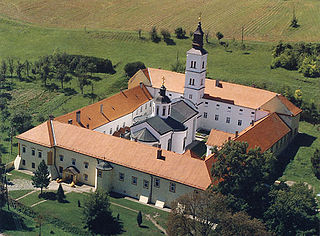
The Serbian Orthodox Church is one of the autocephalous Eastern Orthodox Christian churches.

The Krušedol Monastery is a Serbian Orthodox monastery on the Fruška Gora mountain in the Syrmia region, northern Serbia, in the province of Vojvodina. The monastery is the legacy of the last Serbian despot family of Syrmia - Branković. Dedicated to the Annunciation to the Blessed Virgin Mary, it has been described as the "spiritual beacon" of Fruška Gora and "Second Studenica".
Pavle or Pavel Đurković was a Serbian painter, portraitist and iconographer who distinguished himself in the iconography of monasteries and portraits of great personalities.

The Eparchy of Srem is an eparchy (diocese) of the Serbian Orthodox Church in the Syrmia (Srem) region, Serbia. Most of the eparchy is in the autonomous province of Vojvodina, and it also includes a small south-eastern part of Syrmia within the city limits of Belgrade, as well as some West Syrmian parishes in the border region of Croatia. The seat of the eparchy is at Sremski Karlovci. Since 1986, the diocesan bishop is Vasilije Vadić.

The Eparchy of Banat is an ecclesiastical territory or eparchy of the Serbian Orthodox Church in the Banat region, Serbia. It is mostly situated in the autonomous province of Vojvodina, while the eparchy also includes a small south-western part of Banat that belongs to the City of Belgrade as well as village of Ostrovo that belongs to the city of Požarevac. The seat of the eparchy is in Vršac.

The Metropolitanate of Karlovci was a metropolitanate of the Eastern Orthodox Church that existed in the Habsburg monarchy between 1708 and 1848. Between 1708 and 1713, it was known as the Metropolitanate of Krušedol, and between 1713 and 1848, as the Metropolitanate of Karlovci. In 1848, it was elevated to the Patriarchate of Karlovci, which existed until 1920, when it was merged with the Metropolitanate of Belgrade and other Eastern Orthodox jurisdictions in the newly established Kingdom of Serbs, Croats and Slovenes to form the Serbian Orthodox Church.

Metropolitan Anthony was a bishop of the Russian Orthodox Church in the Russian Empire, the Metropolitan of Kiev and Galicia, who after the defeat of Gen Pyotr Wrangel's White Army in South Russia in November 1920 emigrated and in 1921 settled down in Sremski Karlovci, Serbia. He, along with several other Russian bishops in exile, established an independent Russian church administration that sought to embrace all Russian Orthodox diaspora, known as the Russian Orthodox Church Outside Russia (ROCOR).

Nikanor Grujić was the Serbian Orthodox bishop of Pakrac, the locum tenens Serbian Patriarch, the Austro–Hungarian emperor's Privy Councilor, knight of the Grand Cross of the Franz Joseph order, member of Houses of Magnates at Hungarian and Croatian–Slavonian parliaments, member of Serbian Learned Society, writer, poet, orator and translator.

Archbishopric of Belgrade and Karlovci is the central or patriarchal eparchy of the Serbian Orthodox Church, with seat in Belgrade, Serbia. The head of the eparchy is the Serbian patriarch.
Vikentije Popović-Hadžilavić was metropolitan of the Serbian Orthodox Metropolitanate of Karlovci, and the highest-ranking prelate of the Serbian Orthodox Church in the Habsburg Monarchy, from 1713 to 1725.

Mojsije Petrović was the first Metropolitan of the unified Metropolitanate of Belgrade and Karlovci, from 1726 to 1730. As such, he exercised great influence among the Serbian and Romanian Orthodox faithful in the Habsburg Monarchy.

Inokentije Pavlović was the Metropolitan of Belgrade, head of the Serbian Orthodox Church in the Kingdom of Serbia from 1898 until his death in 1905. He is the father of war artist Dragoljub Pavlović (1875-1956) and Chetnik freedom-fighter Aleksandar "Aca" Pavlović who died in the Macedonian Struggle on 27 July 1907 in Kučevište.

Melentije Pavlović was the first Serb Metropolitan of Belgrade, head of the Serbian Orthodox Church in the Principality of Serbia from 1831 until his death in 1833, as well as a participant in the Second Serbian Uprising.

Mihailo Jovanović was the Metropolitan of Belgrade from 1859 to 1881 and again from 1889 until his death in 1898.
Sofronije Podgoričanin was a Serbian Orthodox bishop who served in the Eparchy of Slavonia from 1705 to 1710 and was elevated to the Metropolitan of Krušedol from 1710 to 1711.

Teodosije Mraović (1815–1891) was the Metropolitan of the Eastern Orthodox Church in the Kingdom of Serbia from 1883 to 1889. Mraović was a hierarch of the Metropolitanate of Karlovci before moving to Serbia in 1843, and eventually taking over the post of the sacked Metropolitan of Belgrade Mihailo Jovanović.
Anthimus was Eastern Orthodox Metropolitan of Belgrade from 1827 until 1831.
Bishop Jovan Jovanović was the Serbian Orthodox Bishop of Bačka before and during Karađorđe's Serbia, from 1786 to 1805. He was involved in inspiring the people in their determination to overthrow the Turkish yoke.
Sava Petrović was a Serbian icon painter and portraitist. He was the father of international portraitist Pavel Petrović, the globetrotter.
















